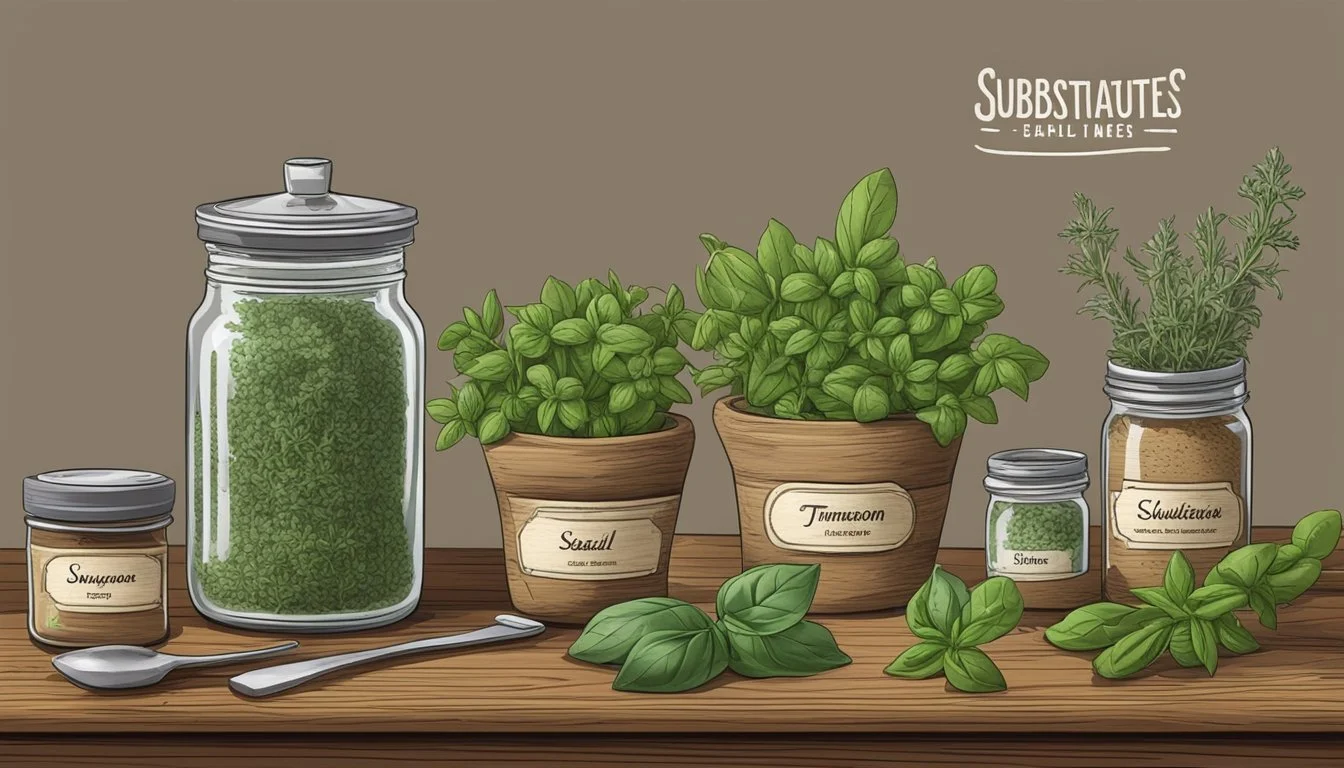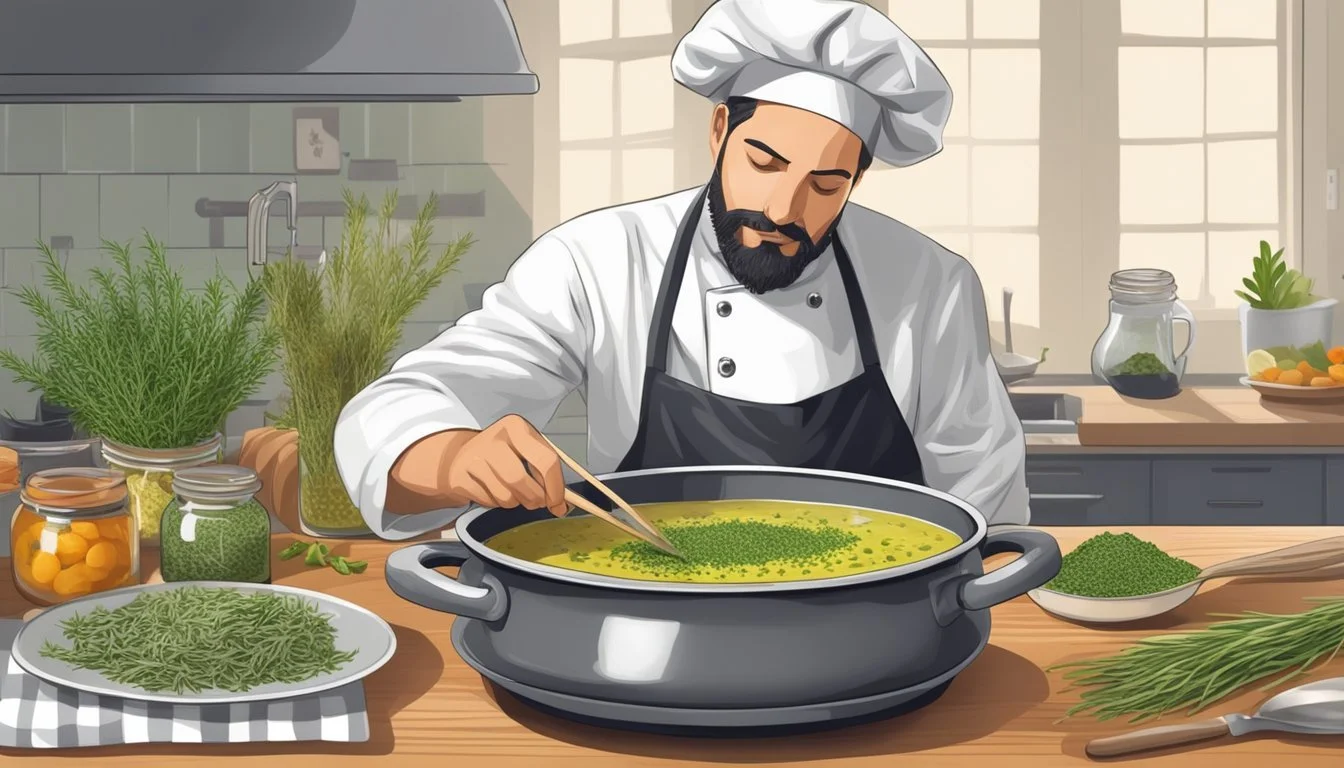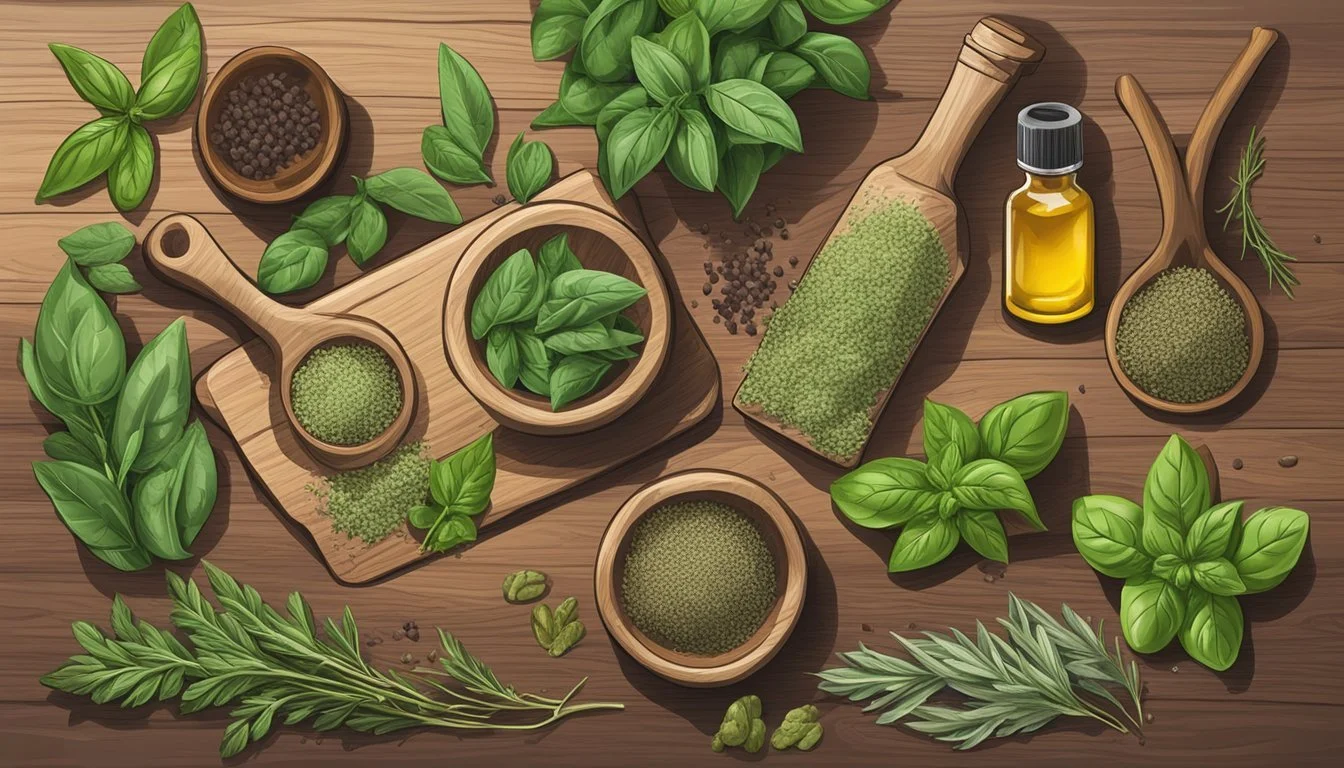Tarragon Substitutes
Top Alternatives for Your Recipes
Tarragon is a perennial herb favored for its aromatic, licorice-like flavor that plays a pivotal role in French cuisine. As a versatile ingredient, it imparts a distinctive taste in a variety of dishes from sauces to seasoned meats. Often found in its fresh form during its growing season, tarragon can also be used dried, which offers a more subtle flavor profile. The herb’s unique taste is a result of its rich essential oil content, particularly estragole, giving it a slightly sweet and spicy aroma.
In the culinary world, finding an adequate substitute for tarragon can be a puzzling yet essential task when fresh or dried tarragon isn't available. Cooks can consider several other herbs and spices that mimic tarragon's flavor to a certain extent. These substitutes are sought to maintain the integrity of dishes where this herb plays a critical role without compromising the overall flavor experience.
When selecting substitutes for tarragon, understanding the context of its use in a recipe is crucial. For instance, in recipes where tarragon is the star ingredient, such as in Béarnaise sauce, choosing a substitute that can replicate its warm, bittersweet taste is important. Common alternatives include herbs like chervil, fennel fronds, and anise seed, which share similar licorice notes, while other herbs like basil and dill may be used in situations where a less pronounced anise-like flavor is desired.
Understanding Tarragon
Tarragon is a distinctive herb frequently used in French cuisine, known for its unique flavor that contributes to a variety of dishes, from simple egg preparations to complex sauces.
Culinary Uses
Tarragon is a staple herb in French cooking. It's incorporated extensively in recipes for stews, soups, and sauces. The herb is particularly noted for its vital role in Bearnaise sauce, a classic French sauce that is often served with steak. It's also common in recipes that feature eggs, meat dishes, and various recipes where a subtle hint of licorice can enhance the overall taste.
Eggs: adds a subtle, yet intricate flavor to omelets and scrambled eggs.
Meat dishes: complements chicken and fish with its aromatic qualities.
Bearnaise sauce: essential for authentic flavor.
Flavor Profile
The flavor profile of tarragon is markedly characterized by an anise or licorice-like taste, described as slightly sweet with a gentle bitter undertone. This aroma contributes an earthy complexity to dishes. The intensity of the flavor varies between fresh and dried tarragon, with fresh leaves generally offering a more balanced and vivid licorice taste.
Anise/Licorice-like taste: a distinct sweet, yet subtly spicy flavor.
Fresh vs. Dried: Fresh tarragon is usually preferred for its vibrant taste and aroma.
Types of Tarragon
There are two main types of tarragon used in cooking: French tarragon and Russian tarragon. French tarragon is favored for culinary use due to its more pronounced and refined flavor. It exudes a sweet, yet potent licorice-like taste that is sought after in gourmet recipes. Russian tarragon, on the other hand, is more robust and aggressive but has less flavor and is generally considered inferior in a culinary setting.
French Tarragon: Known for its delicate, licorice-like flavor, it is the preferred choice in culinary applications.
Russian Tarragon: Less flavorful; it has a coarser texture and is more bitter.
Tarragon Substitutes
When a recipe calls for tarragon and it’s not available, there are several herbs and spices that can replicate its unique flavor profile or provide a complementary taste.
Similar Flavor Substitutes
Fennel and anise seed share a licorice-like taste akin to tarragon. To maintain flavor balance:
Fennel fronds: Use equal amounts as tarragon.
Anise seed: Much stronger, so start with a small pinch for each tablespoon of tarragon needed.
Common Herb Alternatives
Several widely used herbs can effectively replace tarragon in recipes, including options from the Lamiaceae, or oregano family:
Chervil: Offers a mild anise flavor; use a 1:1 substitution ratio.
Basil: Can be used in a 2:1 ratio for a fresh, slightly sweet flavor.
Dill: Provides a grassy note, suitable for fish dishes; use in equal amounts.
Parsley: Though more subtle, adds freshness; use a 1:1 ratio.
Unique Substitutes
Herbs that provide a distinct yet supportive flavor profile as a tarragon substitute include:
Rosemary: Its minty quality is mild, but use sparingly to avoid overpowering dishes.
Thyme: With a slightly minty flavor, matches well with chicken and stews, using a 1:1 ratio fresh or dried.
Angelica: Substitute in the same amount for a similar flavor, especially in soups and stews.
Marjoram: Related to oregano, marjoram offers a sweet pine and citrus flavor; use in a 1:1 ratio.
Substitution Considerations
When choosing a tarragon substitute, it's vital to consider the unique flavor profile of tarragon, proper proportions, and potential allergies to ensure the replacement herb complements the dish without overpowering it or causing adverse reactions.
Taste Matching
Tarragon has a distinctive flavor with hints of licorice and mild vanilla, often described as sweet and slightly peppery. When substituting, the chosen herb should carry a similar flavor profile to blend seamlessly into recipes. Aniseed and fennel are closest in mimicking tarragon’s licorice notes, while dill and basil can be used to replicate its subtle sweetness and aromatic qualities.
Proportions and Measurements
The intensity of the substitute's flavor often dictates the quantity used. Here is a guideline table to ensure balance in your recipes:
Tarragon Quantity Fresh Substitute Dried Substitute 1 tablespoon 1 tablespoon 1/2 tablespoon 1 teaspoon 1 teaspoon 1/2 teaspoon
Fresh herbs generally have a milder flavor than their dried counterparts, so using a 1:1 ratio for fresh substitutes and a 2:1 ratio for fresh to dried is recommended.
Allergy Considerations
Allergies to herbs are rare, but they do occur. It’s important to confirm that the tarragon substitute does not contain compounds that might trigger a reaction. Aniseed, for example, shares a compound called estragole with tarragon, which is allergenic for some individuals. Those with allergies should always consult with a healthcare provider before using new herbs in their recipes.
Culinary Applications of Substitutes
When cooking without tarragon, selecting the right substitute can preserve the integrity of a dish's flavor profile. Choosing an alternative involves matching the mild, slightly sweet anise-like notes of tarragon with herbs and seeds that can offer a similar essence to various dishes, from proteins to vegetarian creations.
For Proteins
When tarragon is called for in recipes involving proteins like chicken, fish, meat, or poultry, aniseed can serve as a suitable replacement due to its licorice flavor, which complements the mild flavors of these proteins. A delicate herb like chervil may also be used, especially in French cuisine, but it should be added at the end of cooking to maintain its freshness and flavor. Here are some specific pairings:
Chicken: Substitute with equal amounts of fresh chervil or a pinch of aniseed.
Fish: Use fennel fronds as a garnish or incorporate them into a light vinaigrette.
Meat & Poultry: Incorporate a mixture of herbes de Provence for a Mediterranean touch.
In Vegetarian Dishes
In vegetarian dishes (What wine goes well with vegetarian dishes?), particularly those featuring eggs, cheese, and vegetables, alternatives like dill or basil can be used. These herbs can offer a bright and aromatic quality to salads, cheese blend, and egg dishes. When making salad dressings or vinaigrettes, a small amount of fennel seed or anise seed can be whisked in to echo tarragon's characteristic taste.
Eggs: Dill imparts a fresh flavor that works well in omelets or quiches. (What wine goes well with quiche?)
Salads: Basil leaves add a fresh, peppery touch ideal for green salads.
Vegetables: Roasted or steamed vegetables can be elevated with marjoram or oregano.
Seasoning Blends and Sauces
Finally, in seasoning blends and sauces where tarragon is typically a star, such as Béarnaise sauce or herbes de Provence, one must carefully choose a substitute that provides a similar aromatic quality without overpowering the dish. Rosemary and fennel work well within seasoning blends for meats and stews, while oregano and marjoram can be part of a rub for grilling.
Béarnaise Sauce: Use chervil or a touch of dried fennel seed for its anise flavor.
Herbes de Provence: Blend in dried marjoram or basil for their savory and sweet overtones.
Health and Nutrition
When exploring tarragon substitutes with regards to health and nutrition, one must look at their nutritional value and consider any dietary restrictions that could influence choice.
Nutritional Benefits
Each herb considered as a substitute for tarragon has its own unique nutritional profile. They typically offer a range of vitamins and minerals, though in varying amounts. For example, basil contains vitamin K, essential for blood clotting, and oregano is rich in antioxidants that help to protect the body from free radicals.
Fennel: High in Vitamin C, fiber, and potassium.
Anise: Known to have iron, which is crucial for blood health.
Many of these substitutes align well with vegetarian and vegan diets, as they are plant-based and contribute to the variety of nutrients required for a balanced diet.
Dietary Restrictions
When substituting tarragon, especially for those with dietary restrictions, it’s important to consider potential allergens. Some individuals might be allergic to specific herbs, and care should be taken to choose a substitute that does not trigger an allergic reaction.
Allergies: Certain herbs like fennel or anise seeds might pose risks to individuals with specific plant family allergies.
Herbs are generally permissible in most diets, including gluten-free, low-carb, or Mediterranean diets, due to their minimal caloric content and substantial flavor enhancement capabilities in cooking. However, if an individual is observing a strict diet where even small changes matter, the nutrient composition of the herb should be taken into account.
Growing and Preservation
When cultivating and preserving tarragon, one must consider the distinct needs of the plant. Success rests on understanding the different tarragon varieties and optimal storage techniques.
Cultivating Tarragon
French tarragon (Artemisia dracunculus) is superior in flavor and is the preferred variety for culinary use. It thrives in well-drained soil with full to partial sun exposure. Since French tarragon rarely flowers, it's propagated mainly through root division or cuttings, ensuring genetic consistency.
Russian tarragon, on the other hand, is more robust and grows larger but is less flavorful. Gardeners can easily cultivate it from seeds, making it a more common but less desired variant. Its resilience to different conditions makes it suitable for a broader range of climates.
Optimal Conditions for French Tarragon:
Sun: Full to partial sun
Soil: Well-drained, fertile
Propagation: Cutting or root division
Watering: Moderate, avoid waterlogging
Optimal Conditions for Russian Tarragon:
Sun: Full sun
Soil: Tolerant of various soil types
Propagation: Seed
Watering: Drought-tolerant, low maintenance
Harvesting and Storing
Harvesting tarragon correctly contributes to its longevity and flavor preservation. The leaves of tarragon should be picked before the plant flowers, ideally in the morning when their essential oils are most potent. For preserving freshness, one can wrap damp paper towels around the herbs and refrigerate them in airtight containers. This method can maintain freshness for about two weeks.
Drying tarragon intensifies its flavor, making it suitable for dishes requiring longer cooking times. To dry tarragon, gardeners can hang bundles in a well-ventilated area away from direct sunlight, ensuring thorough dehydration. Once dry, tarragon should be stored in airtight containers, away from light and heat to maximize shelf life, which can extend to several months.
Harvest time: Before flowering, morning
Method: Refrigerate in airtight containers with damp paper towels
Shelf life: Approximately two weeks
Drying method: Hung in well-ventilated, dark area
Storage: Airtight containers, cool, dark place
Shelf life: Several months
Conclusion
When cooking and tarragon is unavailable, several alternatives offer a similar flavor profile, suitable for various dishes. A cook may opt for fresh or dried herbs like marjoram, oregano, or basil, each bringing a distinct essence to the plate. Dill, rosemary, fennel, and anise seed provide complementary notes, particularly when replicating dried tarragon's unique taste.
For an accurate flavor match, consider using aniseed due to its licorice-like taste. This substituent should be used sparingly as its intense flavor can be overpowering. In replacement ratios:
1 tablespoon of fresh tarragon = 1 tablespoon of fresh oregano (or 0.5 tablespoons if dried)
1 tablespoon of dried tarragon = 1 teaspoon of dried basil
These substitutions ensure the dish maintains its intended flavor complexity without compromising the overall culinary experience. It's essential for chefs to remember that substitution proportions can be adjusted based on the recipe and personal taste preference.






